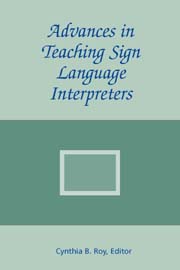Cynthia B. Roy, Editor
Foreword by Franz Pöchhacker
|
View the table of contents. View the list of contributors. Read the foreword. Read the introduction. Read an excerpt. Read a review. |
$63.25s print edition $63.25 e-book |
Interpreter Education, Volume 2
From Interpreting, International Journal of Research and Practice in Interpreting, cont’d.
The contribution by Melanie Metzger provides an interesting overview of general steps applicable to any course focusing on signed interpreter-mediated interaction. It covers how to recognize features of interactive discourse, understand strategies for coping with them, and apply those strategies during interpreting. The interactive discourse phenomena covered are: introductions, summonses, turn-taking and overlap, responses to questions, requests for clarification, relaying of pronominal reference and source attribution. This last feature dominates more than half of the paper. Four main types are outlined: body shift, eye gaze, pointing of the index finger to the source of the utterance, name or description. Teaching strategies including video viewing and role play with deaf and hearing participants, including group interaction, are suggested in order to incorporate source attribution and help students find interlingual interactional equivalence. The paper is slightly imbalanced as it provides greater detail on features of interactive discourse than on teaching.
Insights gained from analyzing omissions from Auslan (Australian Sign Language) to English interpretation are offered by Jemina Napier. She shows how Students can be encouraged to reflect on the reasons for omissions and their impact on interpreted messages. In comparative sign-language discourse analysis there is a tendency to identify omissions as errors or miscues, together with additions, substitutions and intrusions (e.g. Cokely 1992), but Napier points out that interpreting can be successful even if omissions are made, whether caused by error or made consciously. Indeed, the author emphasizes omissions not only as errors but also as strategic coping devices and provides a useful taxonomy of five types (see also Napier 2004). The paper is mainly concerned with the description of classroom applications to learn how to predict the omission potential of an interpreted text in order to teach students to “recognize sources of demand and how they may assert control (Dean and Pollard 2001) through the use of omissions” (p. 134).
The question of teaching students interpreting theory and then teaching them how to apply it in a realistic manner is the next topic to be addressed. Robert G. Lee discusses applications of Cokely’s sociolinguistic model (1992) and his taxonomy of miscues which offer helpful insights for students, teaching them that monitoring their own work is essential. Lee proposes a ‘three-chair’ exercise where one student watches a source-language video on a familiar or novel topic for 15 to 20 minutes. S/he must paraphrase and provide the ‘interpreter’ (who is also watching the tape) with information only in the source language. A third student (who cannot see the tape) can only provide assistance on the target-language production and not on questions of meaning. No indication is made regarding directionality (sign-to-sign or sign-to-voice or vice versa); presumably any direction is viable.
Cynthia B. Roy is a retired professor in the Department of Interpretation and Translation at Gallaudet University, where she directed the BA program and the PhD program. She is also a nationally certified American Sign Language–English interpreter specializing in community interpreting.
Print Edition: ISBN 978-1-56368-320-6, 6 x 9 casebound, 224 pages, tables, figures, references, index
$63.25s
E-Book: ISBN 978-1-56368-391-6
$63.25
To order by mail, print our Order Form or call:TEL 1-800-621-2736; (773) 568-1550 8 am - 5 pm CST
TTY 1-888-630-9347
FAX 1-800-621-8476; (773) 660-2235
